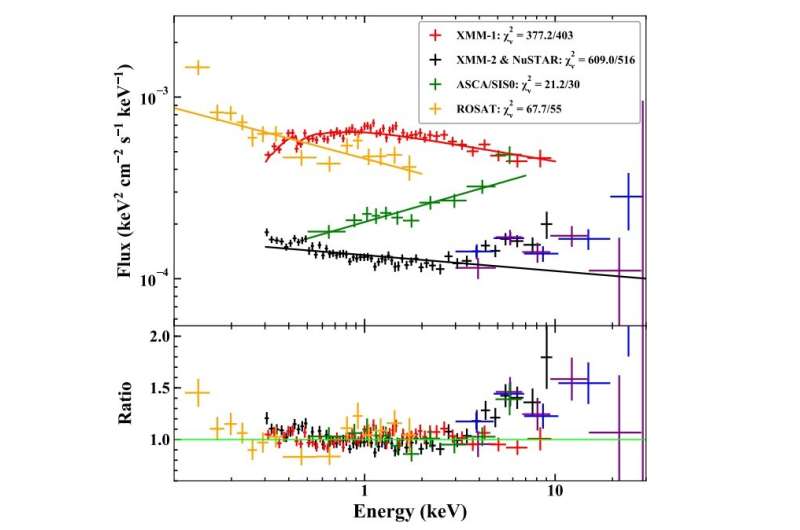April 4, 2022 report
Active galaxy RXJ0134.2-4258 investigated in detail

Using XMM-Newton and NuSTAR satellites, astronomers have conducted a comprehensive, long-term multiwavelength study of an active galaxy known as RXJ0134.2-4258. Results of the observational campaign, published March 25 on arXiv.org, shed more light on the nature of this source, revealing its peculiar properties.
Active galactic nuclei (AGNs) are accreting, supermassive black holes residing at the centers of some galaxies, emitting powerful, high-energy radiation as they accrete gas and dust. These nuclei can form jets, having mostly cylindrical, conical or parabolic shapes, which are observed even on megaparsec scales.
Narrow-line Seyfert1 (NLS1) galaxies are a subclass of AGN, characterized by a Balmer (Hβ) line-width, which is narrow compared to standard broad line AGN, but still broader than the narrow lines. They usually have smaller black hole masses and higher Eddington ratios when compared to the entire AGN population, however, some NLS1s may accrete with normal or low Eddington ratios.
At a redshift of 0.237, RXJ0134.2-4258 is one of such NLS1 galaxies. Discovered in 1999 by the ROSAT all sky survey, the galaxy showcases a typical optical spectrum of an extreme NLS1, including narrow Balmer lines. The mass of the black hole in this system is estimated to be about 15 million solar masses, while its Eddington ratio was calculated to be relatively high—at a level of approximately 10.0.
Previous observations of RXJ0134.2-4258 have found that it exhibits some highly unusual properties when compared to other typical NLSs. For instance, it showcases dramatic X-ray variability, resembling an X-ray complex NLS1, but the spectrum becomes harder-when-brighter, which is not normally observed in AGNs with high Eddington ratios. A team of astronomers led by Chichuan Jin of University of Chinese Academy of Sciences in Beijing, China, inspected this source in X-rays using XMM-Newton and NuSTAR, hoping to shed more light on this perplexing nature.
The two space telescopes observed RXJ0134.2-4258 in one of its lowest X-ray flux states. It was found that X-ray time-average spectra of this source exhibited dramatic variations in terms of both flux and spectral shape during the past 23 years. It was added that no significant soft excess was detected in any of these spectra.
The researchers underlined that the time-average spectrum from XMM-Newton observations showcased a steep rise above 4 keV, suggesting the presence of a separate hard X-ray component. They also performed a time lag analysis, finding that this component lags behind the soft X-rays by about 4,000 seconds in the low frequency band. No other lags were found below 4 keV.
Furthermore, the astronomers compared their results to previous studies of RXJ0134.2-4258. In result, it was found that this NLS1 experienced very different X-ray spectral-timing properties during its X-ray low and high-flux states, which includes much weaker X-ray variability in the low-flux state.
The authors of the paper concluded that the observed properties and X-ray variability of RXJ0134.2-4258 may indicate the presence of a clumpy disk wind in this source. They added that such winds are expected in highly super-Eddington NLS1s.
More information: Chichuan Jin et al, Multi-wavelength Campaign on the Super-Eddington NLS1 RX J0134.2-4258 – I. Peculiar X-ray Spectra and Variability. arXiv:2203.13419v1 [astro-ph.HE], arxiv.org/abs/2203.13419
© 2022 Science X Network




















